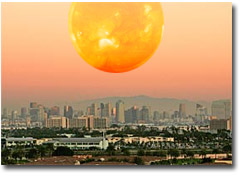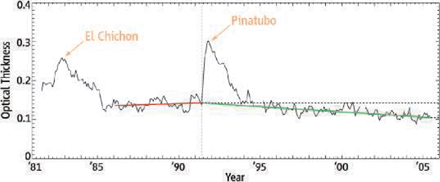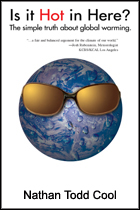GreehouseTruth Blog :: Another Natural Climate Cause

|
|
|
|
|
Another Natural Climate Cause Revealed
Recent reductions in haze may explain expedited global warming
Posted May 10, 2007 by Nathan Cool
 Amidst the flurry of media bombardments regarding the dire state of our planet, an important footnote has been omitted all too frequently: no one
can explain why Arctic ice is melting at breakneck speed, and climate models can't explain why climate change has zoomed along faster
than expected, especially over the past two decades. If you lean your ear toward the "sky is falling" camp (Ex VP's included) for answers, you'll inevitably get a finger of blame pointed at you and your SUV. Even Reuters recently published an article,
"Arctic Ice Cap Melting 30 Years Ahead of Forecast", warning that the infamous home of Santa Claus could be a northern kind of
Waterworld (minus of course Costner and cast from the 1995 sci-fi futuristic Hollywood phantasm) by the year 2020 -- three decades ahead of schedule from IPCC predictions. Although the media may lack desire to cover uncertainties surrounding climate change, science remains on a never-ending quest for answers (after all, that is what "science" is all about). And, something recently published in the prestigious journal Science may bring us one step closer to understanding why global warming is taking the heavy hand that it has as of late. Interestingly enough, it has little to do with you or me; instead, Mother Nature once again takes center stage.
Amidst the flurry of media bombardments regarding the dire state of our planet, an important footnote has been omitted all too frequently: no one
can explain why Arctic ice is melting at breakneck speed, and climate models can't explain why climate change has zoomed along faster
than expected, especially over the past two decades. If you lean your ear toward the "sky is falling" camp (Ex VP's included) for answers, you'll inevitably get a finger of blame pointed at you and your SUV. Even Reuters recently published an article,
"Arctic Ice Cap Melting 30 Years Ahead of Forecast", warning that the infamous home of Santa Claus could be a northern kind of
Waterworld (minus of course Costner and cast from the 1995 sci-fi futuristic Hollywood phantasm) by the year 2020 -- three decades ahead of schedule from IPCC predictions. Although the media may lack desire to cover uncertainties surrounding climate change, science remains on a never-ending quest for answers (after all, that is what "science" is all about). And, something recently published in the prestigious journal Science may bring us one step closer to understanding why global warming is taking the heavy hand that it has as of late. Interestingly enough, it has little to do with you or me; instead, Mother Nature once again takes center stage.
The Science paper, "Long-Term Satellite Record Reveals Likely Recent Aerosol Trend" can be found here (note Full Text access requires AAAS membership). The study that was undertaken for this report was conducted by scientists from NASA's Goddard Institute for Space Studies. Using satellite data over the past couple decades, the NASA team found that the sunlight-reflecting haze which cools much of the planet seems to have thinned in recent times. A chart of this from the Science paper is shown below.

This chart shows the thickness of the upper atmospheric haze that produces "global dimming." In chapter 4 of Is it Hot in Here, I dedicated a section titled "Erupting Hazards" that discusses this antithesis to global warming, and how this blocking of sunlight is oftentimes related to volcanic eruptions. In the chart above, this is evident from the two peaks showing the El Chichon and Pinatubo eruptions -- volcanic events that created cooling across the planet. As the chart also shows (depicted by the green line), haze, just like that created from volcanic eruptions has been declining steadily since the early 1990s.
Increase the sunlight-blocking haze surrounding planet Earth -- which often happens after major volcanic events -- and the Earth cools. Remove this haze though, and the opposite occurs: we heat up. If the data provided by the NASA study is correct, then a good deal of warming that's occurred in the past couple decades could simply be due to a natural reduction in upper atmospheric aerosols. This of course is not the only natural element that could be warming our world, something I discussed in another blog here, when I talked about a NOAA report that showed a strong, natural, warming cycle taking place.
The primary problem with all of this though -- as I so often point out -- is the polarization of climate change beliefs. People (and politicians) often think the cause of global warming is attributed to either natural or human-induced causes, thinking that either answer A or B is correct, when forgetting that there is oftentimes answer "C": all of the above. The recent study by NASA regarding haze, as well as other natural element discoveries, are merely just some of the pieces comprising the puzzle of our planet's climate -- a conundrum riddled with the "C" kind of answers. Knowing that humans and nature are heating up the planet though raises an even bigger question: How much of global warming is natural, and how much is human-induced?
Inquiring minds (including mine) want to know, but the answer to this question is about elusive as the answer to whether there is a God (or which one to have faith in). Everyone will answer that question differently. The topics surrounding climate change often fall into this pit of debate as well, and only time, coupled with rigorous research will reveal answers.
In the meantime, should we continue to drive gas-hogging SUV's and burn coal for electricity? Heck no! We do know that CO2 is a greenhouse gas that has been increasing since the Industrial Revolution from the advances (and hence over-usage) of humankind. We also know that methane is in higher abundance as well from a variety of things culpable from the hand of man. But there is danger in sermonizing that the sky is falling, just to have everyone turn a deaf ear years from now to those ostensibly seen as merely crying wolf. Knowing the facts, not hyperbole, can lead to long-term change -- not just a temporary fad.
Science trudges along to find answers so that we can face the future with certainty (or at least as much as can be expected). The media though continues to cherry-pick the truth, and this recent finding by NASA seems to have fallen through the cracks. Doing a Google News Search for "thinning haze" and "climate aerosols", revealed no mention of the Science paper published by NASA. Interestingly enough though, a similar article published by the "Alfred Wegener Institute for Polar and Marine Research" in Europe did publish a bit of news that the Arctic air is surprisingly cleaner than usual this spring (click here to read that article).
This latest finding from NASA is fresh, and as with all discoveries, will be subjected to scrutiny soon. I doubt though that any of us will hear anything about it on the evening news, or in Oscar-winning documentaries by ex-politicians.
|
To stay abreast on similar articles like this, you can signup for the free GreenhouseTruth newsletter. Additional information on climate events, global temperatures, sea ice extent, and other topics discussed in this blog can be found in Nathan Cool's new book, Is it Hot in Here?--The simple truth about global warming. Click here to get your copy. |

|
